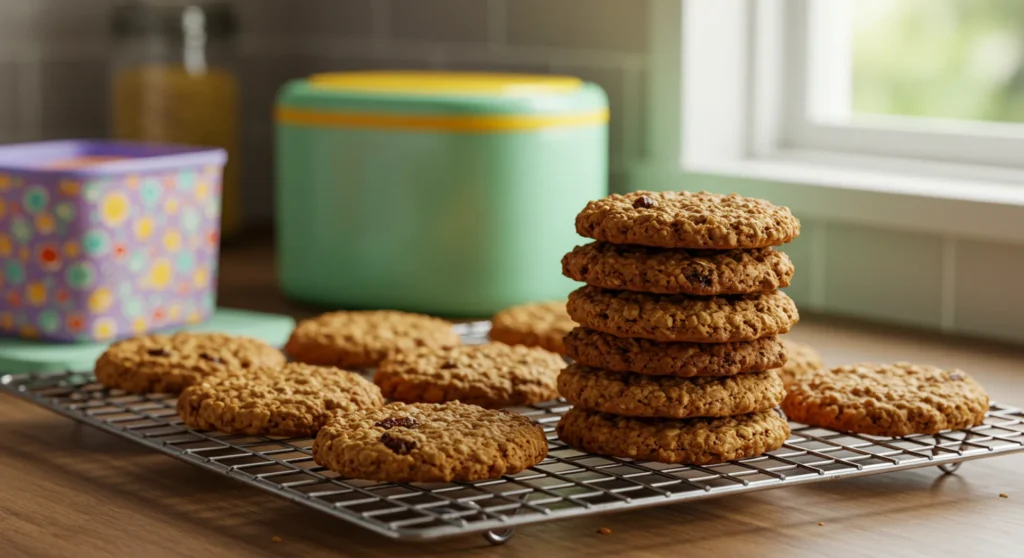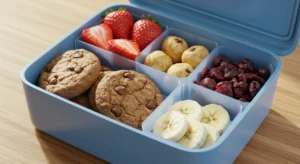School events, lunchboxes, and classroom parties almost always call for cookies. But with food allergies on the rise, many schools have adopted strict “no eggs, no dairy, no nuts” rules. That might sound limiting, but the truth is you can still make amazing school-safe cookies that taste just like the classics. By learning a few simple swaps, you can bake cookies that are chewy, sweet, and completely safe for kids to share with their friends.
Why Make School-Safe Cookies?
Baking school-safe cookies isn’t just about following allergy guidelines — it’s about inclusion. When kids see a tray of cookies come into the classroom, everyone should be able to grab one without worry. Food is often the centerpiece of classroom celebrations, but if a cookie has butter, eggs, or milk, it may exclude children with allergies. Using school-safe recipes ensures every child feels welcome, included, and excited to join in.
Common Allergens to Avoid
- Eggs: Provide structure and binding in traditional recipes, but many alternatives mimic this role perfectly.
- Dairy: Butter and milk are staples in cookies, yet plant-based fats and milks provide the same richness.
- Nuts: Many schools are nut-free zones. Stick with seeds, seed butters, or safe chocolate chips.
By avoiding these common allergens, you don’t just make cookies safe — you make them shareable. That’s what school-safe baking is all about.
The Science of Cookie Swaps
Baking is often compared to chemistry because small changes can make big differences. That’s why finding the right swaps matters. Eggs, dairy, and butter each have unique roles in cookies. The trick is to replace not just the ingredient, but the function it provides.
Replacing Eggs
- Flaxseed “egg”: Mix 1 tablespoon ground flax with 3 tablespoons water. As it sits, it thickens into a gel that binds dough like eggs do.
- Unsweetened applesauce: Adds moisture and a touch of sweetness. One-quarter cup equals one egg.
- Mashed banana: Another great binder with natural sugar. Best in chocolate-based or oatmeal cookies.
Replacing Dairy
- Milk: Use oat, soy, or rice milk for mild flavors. Coconut milk works well in richer cookies.
- Butter: Coconut oil and plant-based butter sticks provide the fat and moisture cookies need. Sunflower oil is a nut-free option.
- Chocolate chips: Choose dairy-free brands made with cocoa butter instead of milk fat.
Balancing Texture
Eggs add structure, and butter adds richness. Without them, cookies can sometimes turn out flat or crumbly. That’s why using a combination of swaps often works best. For example, pairing applesauce with coconut oil gives both binding and moisture, keeping cookies chewy rather than dry.
Easy School-Safe Cookie Recipes
Here are two tried-and-true recipes that are simple, delicious, and perfect for classrooms or lunchboxes.
Dairy-Free Chocolate Chip Cookies
- 1/2 cup coconut oil or vegan butter
- 1/2 cup brown sugar
- 1/4 cup unsweetened applesauce
- 1 tsp vanilla extract
- 1 1/2 cups all-purpose flour
- 1/2 tsp baking soda
- 1/2 tsp salt
- 1/2 cup dairy-free chocolate chips
Instructions: Cream the oil and sugar, then stir in applesauce and vanilla. Mix dry ingredients separately, then fold them in. Stir in chocolate chips. Scoop onto a lined baking sheet and bake at 350°F for 9–11 minutes. Let cool before serving.
Jam Thumbprint Cookies
- 1/2 cup plant-based butter
- 1/3 cup sugar
- 1 tbsp flax egg (1 tbsp flax + 3 tbsp water)
- 1 tsp vanilla extract
- 1 1/2 cups flour
- School-safe jam of your choice
Instructions: Mix butter and sugar until creamy, then add flax egg and vanilla. Stir in flour until dough forms. Roll into balls and place on a baking sheet. Press a thumb into each cookie and fill with jam. Bake at 350°F for 10–12 minutes.
Tips for Success with School-Safe Baking
- Chill the dough: Egg-free cookies spread faster, so chilling dough for 20–30 minutes helps keep them thick and chewy.
- Check labels carefully: Even “vegan” or “dairy-free” items may be made in facilities that handle allergens.
- Use parchment paper: Prevents sticking and makes cleanup easier.
- Start small: If you’re new to baking without eggs or dairy, bake a small batch first to test flavor and texture.
Creative Cookie Variations
Once you master the basics, try these fun variations that kids love.
Sunflower Butter Cookies
Roll dough balls in sugar before baking. Sunflower butter adds richness without nuts, and kids love the sparkle.
Oatmeal Cranberry Cookies
Use a flax egg to keep them chewy, and add cranberries or raisins for natural sweetness and fiber.
Coconut Snowball Cookies
Roll dough in shredded coconut for a festive, snowy appearance. These are a big hit during the holidays.
Cinnamon Sugar Snickerdoodles
Skip the eggs, and roll balls of dough in cinnamon sugar. Soft and chewy, they taste just like the classic version.
Making It a Family Activity
One of the best parts of baking school-safe cookies is that the steps are simple enough for kids to help with. Baking together becomes more than just making food — it becomes a bonding activity.
- Little kids: Let them pour flour, stir dough, or press thumbprints.
- Older kids: Put them in charge of measuring, timing the oven, or adding creative mix-ins.
- Everyone: Decorating! Whether it’s sprinkles, drizzle, or powdered sugar, decorating is where kids shine.
These moments help children build confidence in the kitchen and create memories that last long after the cookies are gone.
How to Store and Pack School-Safe Cookies
Cookies taste best fresh, but with the right storage, they stay tasty for days. Here’s how to keep them school-ready:
- Room temperature: Store in airtight containers for 2–3 days.
- Freezer: Most egg-free, dairy-free cookies freeze well. Freeze baked cookies or raw dough balls for up to 3 months.
- Lunchbox prep: Pack cookies in silicone bags or small containers. Add fruit or pretzels for balance. If sending for a party, use parchment layers in a tin so they arrive intact.
FAQs About School-Safe Cookies
Can I use gluten-free flour in these recipes?
Yes, a 1:1 gluten-free baking blend works well. Just be aware that texture may be slightly different, sometimes crumblier, so adding a tablespoon of applesauce can help bind the dough.
Do school-safe cookies taste different?
Not at all! When baked correctly, these cookies taste just as sweet, chewy, and comforting as traditional recipes. Most kids won’t notice a difference.
Are store-bought cookies safe?
Some brands sell vegan or allergy-friendly cookies, but always read labels. Homemade cookies give you more control and peace of mind, especially when baking for a classroom.
Related Recipes You’ll Love
If you enjoyed this post, check out our Allergy-Friendly Cookie Recipes for more inspiration. For easy school ideas, don’t miss our Back-to-School Lunchbox Cookies guide filled with family-tested favorites.
Final Thoughts
Baking school-safe cookies doesn’t have to feel overwhelming. With simple swaps and a little practice, you can create egg-free, dairy-free recipes that taste just as good as the originals. These cookies are more than a treat — they’re a way to bring kids together, encourage sharing, and ensure no one feels left out. The next time your child needs to bring cookies for school, bake a batch of these inclusive, delicious treats. You’ll be giving them more than a snack — you’ll be giving them a moment of belonging.




